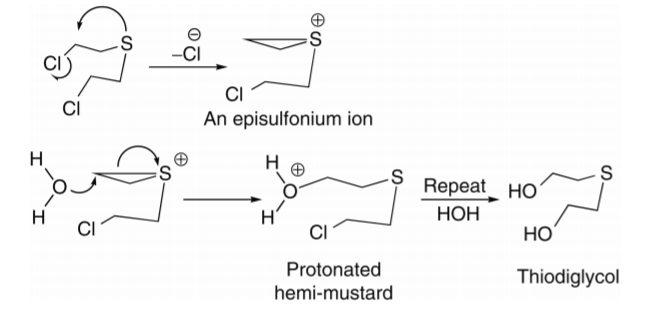Sulfur mustard is a chemical that was widely used as a warfare agent during World War I. Due to being a vesicant, it has well-described effects on a person’s body, including blisters (Jenner 29). Its formula is C4H8Cl2S, and several ways exist to produce the compound (Henderson et al. 24, 25). Although sulfur mustard is mainly known for World War I, more instances occurred after the conflict. This paper will highlight the chemical’s hazards, properties, and warfare usage, determining its danger for humanity.
Sulfur mustard has adverse biological effects on a human’s body. As it is a lipophilic compound, the skin, the eyes, and the respiratory tract easily absorb the chemical (Jenner 32). Consequently, they become irritated, and severe injuries may follow due to gradual tissue destruction (Jenner 44). Blisters usually form on the skin; cellular necrosis is evident, and the healing process is slow (Jenner 45). The eyes are affected by conjunctivitis and photophobia, which develop into blepharospasm (Jenner 45). A necrotic slough is produced in the respiratory tract, potentially blocking lower airways (Jenner 60). The lungs become damages, and pulmonary edema may occur (Jenner 60). Similar effects are observed in the gastrointestinal tract, which results in vomiting and diarrhea (Jenner 60). Sulfur mustard is also hypothesized to affect one’s fertility and serve as a carcinogen, although the former has not been studied thoroughly (Jenner 57, 59). Some effects are accompanied by alterations in DNA, contributing to the pathology (Jenner 32). Overall, sulfur mustard can severely affect the human body, causing irritation, blisters, cellular necrosis, and other condition, including increased cancer risk.
The chemical is a compound which is not produced naturally. It is a yellow-brown liquid with an odor, which is denser than water (1.27 g/mL) and deepens in color with more impurities (Henderson et al. 25). Its vapor density and pressure are 5.4 and 0.072 mm Hg, respectively (Henderson et al. 25). The chemical is miscible in organic solvents and hydrolyzes slowly (Henderson et al. 25). It can be obtained using at least three methods: Meyer’s, the Levinstein process, and the Steinkopf synthesis (Henderson et al. 25). Sulfur mustard is characterized by a heteroatom separate from a leaving group (Henderson et al. 25). The compound is prone to Sn-type reactions, one of which produces an episulfonium ion; using water with the latter leads to thiodiglycol (see fig. 1). Altogether, the chemical’s structure and reactivity determine its adverse effects.

As mentioned, sulfur mustard was used during World War I by Germans. The first attack occurred in 1917 near Ypres, which explains its French name, and about 5% of the soldiers exposed to it died (Friedrich and James 85; Giannakoudakis and Bandosz 28). Afterward, the chemical was used by Italy in Ethiopia in the 1930s, although the country signed the Geneva Protocol previously (Giannakoudakis and Bandosz 28). Other instances include the North Yemen Civil War and the Iran–Iraq War (Giannakoudakis and Bandosz 29). Recently, it has become common for terrorists to use sulfur mustard due to its relative simplicity in production (Giannakoudakis and Bandosz 29). As the antidote still does not exist, the chemical poses a threat to humans (Giannakoudakis and Bandosz 29). Thus, while its usage is limited, sulfur mustard was prominent in several conflicts and now endangers the civilian population.
Sulfur mustard is noted for its irritating effects, which can severely damage one’s skin, eyes, respiratory tract and lungs, and other systems. It contributes to a risk of cancer and may have numerous long-term complications. Due to the variety of production methods, people are able to obtain the compound easily. Nowadays, terrorist organizations tend to use it, although many still associate sulfur mustard with World War I. As the antidote has not been developed, humanity remains threatened by the chemical’s devastating effects.
Works Cited
Friedrich, Bretislav, and Jeremiah Jones. “From Berlin-Dahlem to the Fronts of World War I: The Role of Fritz Haber and His Kaiser Wilhelm Institute in German Chemical Warfare.” One Hundred Years of Chemical Warfare: Research, Deployment, Consequences, edited by Bretislav Friedrich et al., Springer International Publishing, 2017, pp. 25-44.
Giannakoudakis, Dimitros A., and Teresa J. Bandosz. Detoxification of Chemical Warfare Agents: From WWI to Multifunctional Nanocomposite Approaches. Springer International Publishing, 2018.
Henderson, Terry J., et al. “Chemistries of Chemical Warfare Agents.” Chemical Warfare Agents: Biomedical and Psychological Effects, Medical Countermeasures, and Emergency Response, edited by Brian J. Lukey et al., 3rd ed., Taylor & Francis Group, 2019, pp. 17-38.
Jenner, John. “Toxicology of Vesicants.” Chemical Warfare Toxicology, edited by Franz Worek et al., vol. 1, Cambridge, The Royal Society of Chemistry, 2016, pp. 29-80.